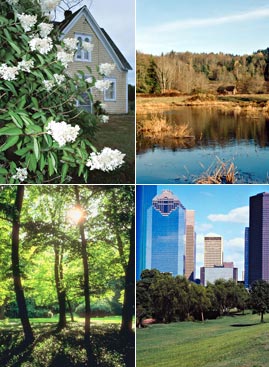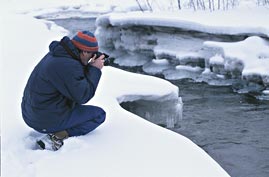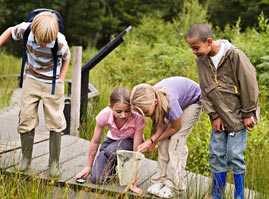teachers'domain: Digital Media for the Classroom and professional Development
User: Preview
Although modern technology has done a great deal to insulate us and protect us from the discomforts and hazards of the natural world, it has also disconnected us from much of our surroundings. However, humankind cannot truly stand apart from the natural world. Many people, especially those who are part of a Native community, continue to find their identity, their culture, and important life lessons in the landscapes and seascapes they call home. Native knowledge emerges from observations and experiences in these environments.
In this activity, you will listen to what people who are deeply connected to the land can tell us about what they are experiencing. You will also have the opportunity to connect, or reconnect, with your surroundings. Getting in touch with nature is not only good for the mind, heart, and soul, it will help you teach topics such as climate change in a more meaningful way. You will keep a journal to track your experience, and keep classroom-planning notes to develop successful activities for your students.
CMS PREVIEW MODE

"The most important thing for a human being is to go back to nature."—Florence Jones, Winnemem Wintu Spiritual Leader
How aware are you of your local environment? Can you observe the interconnectedness of elements of the natural world? A good way to start is with a simple walk outside your door.
Nature walks—whether taken in a park, in your backyard, or in an "urban jungle"—provide ideal opportunities to develop and refine your powers of observation. After all, how can you tell if the environment around you is changing if you don't know what it looks like, sounds like, or feels like?
Materials
To begin this activity, gather the following materials:

Video: 2m 16s
You will begin by watching a video in which Native American Elders explain what it means to be connected to the land. With a perspective formed from lifelong personal observation as well as from knowledge passed down through the generations, they understand the interconnectedness of land, climate, and culture. In this example, the narrators recognize the significance of water in their environment and the effects of climate change on water supply. They observe that their region has become warmer over time and that there is less water running down from the mountains. As a result, there is no streamside vegetation—and no fish—where these used to be abundant.
Now watch the video on the left.

With your journal and sketchpad in hand—and leaving behind any technological devices—take an hour-long walk outside. Give your full attention to the natural world around you. Engage your senses: Stop, look, and listen, but also smell and touch. Appreciate the vibrancy and life that is apparent—whether you happen to be on a backwoods hiking trail or in a busy city center.
Note: If you do not frequently engage with the natural world, you may choose to break the hour-long walk into two or more shorter walks. Each time you repeat the experience, try to refine your observations. Compare your notes from each walk, and ask yourself what the level of detail in your journal notes tells you about your level of attentiveness.
Print out the Nature Journal Writing Prompts (PDF) and refer to the writing prompts during your walk.

Once you've returned to your computer, report on what you experienced.
"What the world needs today is a good dose of indigenous realism."—Dr. Daniel Wildcat, Haskell Indian Nations University
Native peoples have been observing changes in their environment and sharing their knowledge with other members of their community for generations. The survival of indigenous cultures has depended on being attentive to environmental changes and adapting behaviors in response to changing conditions. While we often talk about nature as something external to ourselves—for example, as a collection of resources to be "owned," "managed," or "exploited"—Native peoples would remind us that humankind is part of the natural world and that we have to understand our role in it.
Read the following statements and watch the videos. Reflect on how the meaning of each statement is evident in the corresponding video.

Video: 1m 53s
Nature and culture cannot be considered apart from each other; biological diversity and cultural diversity are strongly connected.

Video: 5m 48s
Tribal knowledge of landscapes and climates has value and should be incorporated into geosciences education and research.

Video: 3m 05s
There is value in regarding the natural world as full of relatives rather than resources.

Video: 1m 21s
The Haskell-Baker Wetlands featured in this video are a vital part of the greater surrounding ecosystem. They help maintain ecological balance. Native people honor and respect nature as a complex system in which everything—plants, animals, wind, water, fire—is believed to possess a spirit. To them, the wetlands are sacred.
Watch the video on the left.
Take a few moments to answer the following questions:
When you do this activity with your class, instead of asking students the meaning of the word sacred, you might ask them: What do you value most deeply? Are there places that you (your family members, your community) would want to protect because of how deeply you value the connections you’ve established with them?

If you have the time and resources, you might extend the activity by creating a media journal that documents your experience. Take a video camera, still image camera, or audio recorder with you as you repeat your journey or explore a new environment. Record what you see and focus on during the walk, as well as your thoughts as they strike you. You can then recreate your experience in a video, audio podcast, or other media presentation that you can share with others. You may also choose to do the following:
Note: If you decide to do this extension activity, check out Learning Through Video Production for some helpful tips and guidelines.

Having completed this exploration, you are now ready to develop a classroom activity for your students. Many Americans spend much of their lives indoors, largely isolated from nature. As a result, many have become ignorant of it. As you have likely discovered, getting outside and experiencing the natural world can lead to a greater appreciation of the need to protect natural areas.
Here are some suggestions for activities you might plan:
For younger students
Organize an outdoor scavenger hunt. Have students make note of sounds and wildlife sightings and perhaps collect something organic like a fallen leaf or decomposing tree bark. Have them observe not only the ground, but also the sky. This activity will encourage students to slow down and notice their surroundings. Then have students write or draw in their journals what they found most interesting or unexpected about their outdoor experience.
For older students
Ask students if they have a favorite place to visit outdoors—somewhere that is meaningful to them or their family. Have them describe how that place has changed over the years. Has it been threatened or even destroyed? (They may wish to interview older relatives or community members to learn more about the history of this place.) Then have them do one of the following:
To help you plan your classroom activity, here is a list of the media used in this activity. Some additional links are included that provide further insights into communities and cultures that maintain a strong connection with their natural surroundings.
Resources referenced in the activity:
Resources referenced in the optional extension activity:
Additional resources for classroom use:
Teachers' Domain, Reconnecting with Your Environment, published March 31, 2010, retrieved on April 5, 2025,
http://www.teachersdomain.org/resource/nasa09.pd.tarecon/
Media Type:
Self-paced Lesson



National K -12 Subject:
Professional Development:
WGBH is trying to develop materials that better meet the needs of our users. Please take this brief survey to share how you use these resources and to provide feedback on your experiences using these materials. Take the Survey!
In this media-rich activity designed for teacher professional development, take a nature walk to observe aspects of your local environment, then plan an activity for students that will help them better understand their own surroundings and how they interact with the natural world.
During this activity, you will spend an hour or so immersed in the environment just outside your door. You will also watch videos that feature Native American people and the environments with which they are interconnected. The experience and insights you gain will then be used to prepare a parallel lesson and experience for your students.
At various stages of the activity, you will be prompted to write down your thoughts and respond to some questions. While you may complete many of these tasks directly on your computer, you might want to use a loose-leaf binder instead, which you can separate according to the sections described below:
You will be asked to record your thoughts on a particular subject or your responses to questions posed in the activity.
Using a journal and/or sketchpad, you will be asked to document your outdoor experience. The journal you create—ideally, a mix of written notes, drawings, and even small collected objects—may serve as a good example for your students when they are preparing for their own outdoor activity.
You will be prompted to record your ideas about ways to help your students complete a similar activity.
To help improve this service, please report and describe any standards correlations that you find to be inaccurate.
Academic standards correlations on Teachers' Domain use the Achievement Standards Network (ASN) database of state and national standards, provided to NSDL projects courtesy of JES & Co.
![]()
We assign reference terms to each statement within a standards document and to each media resource, and correlations are based upon matches of these terms for a given grade band. If a particular standards document of interest to you is not displayed yet, it most likely has not yet been processed by ASN or by Teachers' Domain. We will be adding social studies and arts correlations over the coming year, and also will be increasing the specificity of alignment.
You must be signed in to see standards matches for your state.
 Loading Standards
Loading Standards Teachers' Domain is proud to be a Pathways portal to the National Science Digital Library.
Teachers' Domain is proud to be a Pathways portal to the National Science Digital Library.
Major funding for Teachers' Domain was provided by the National Science Foundation.
Teachers Domain® Home | Change Edition
About Teachers' Domain | Contact Us | Privacy Policy | Terms of Use
Teachers' Domain: © 2002-2025 WGBH Educational Foundation | shopPBS Educational Media
